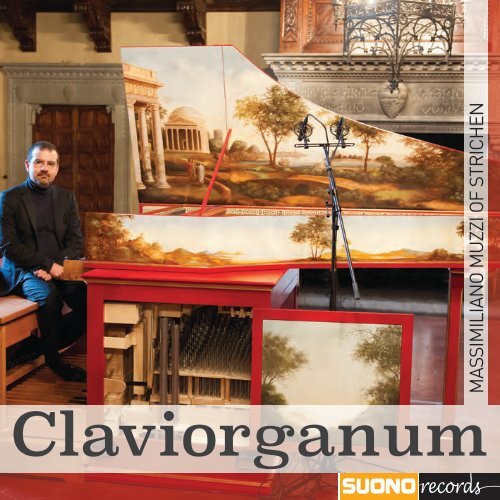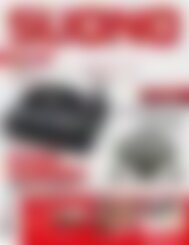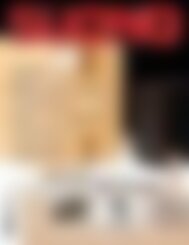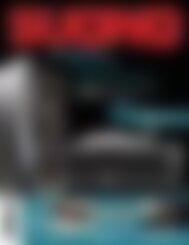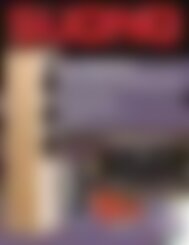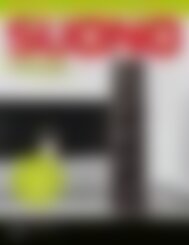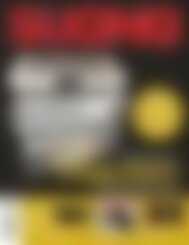Claviorganum - Massimiliano Muzzi of Strichen
Create successful ePaper yourself
Turn your PDF publications into a flip-book with our unique Google optimized e-Paper software.
MASSIMILIANO MUZZI <strong>of</strong> <strong>Strichen</strong><br />
<strong>Claviorganum</strong>
IL CLAVIORGANO PROTAGONISTA DEL '700<br />
<strong>Massimiliano</strong> <strong>Muzzi</strong> <strong>of</strong> <strong>Strichen</strong><br />
<strong>Claviorganum</strong><br />
ORCHESTRA DA CAMERA DEL MAGGIO MUSICALE FIORENTINO<br />
Maestro Concertatore<br />
Lorenzo Fuoco<br />
Ingegnere del suono<br />
Fabio Ferri<br />
Supervisione artistica<br />
Fabio Galadini<br />
Recording Location<br />
Villa Rondielli Vitielli, Fiesole (FI) aprile 2014<br />
laviorganum<br />
<strong>Massimiliano</strong> <strong>Muzzi</strong> <strong>of</strong> <strong>Strichen</strong>
JOHN STANLEy - CONCERTO VI per<br />
CLAVIORGANO e ARCHI, continuo op.10<br />
01. Allegro 4:03<br />
02. Rondeau 4:20<br />
CHARLES WESLEy - CONCERTO n° 4 in Do<br />
MAGG. per CLAVIORGANO, ARCHI e 2 ObOI<br />
03. Allegro 5:10<br />
04. Largo 7:33<br />
05. Allegro moderato 4:16<br />
THOMAS AUGUSTINE ARNE - CONCERTO<br />
PER CLAVIORGANO e ORCHESTRA n° 3 in<br />
La MAGG.<br />
06. Allegro con spirito I 6:49<br />
07. Allegro con spirito II 2:30<br />
08. Minuetto 4:57<br />
09. Moderato 6:02<br />
G.F. HäNDEL - CONCERTO per ORGANO,<br />
ARCHI, 2 ObOI, CONTINUO n° 1 op. 4<br />
10. Larghetto staccato 4:18<br />
11. Allegro 5:18<br />
12. Adagio 1:23<br />
13. Andante 3:42<br />
Total time 60:28
il claviorgano<br />
ProTagoniSTA DEL '700<br />
Il claviorgano fu certamente<br />
impiegato nei concerti per strumenti<br />
a tastiera scritti a Londra nel corso<br />
del XVIII secolo, in quella stagione<br />
musicale tutta londinese che vide un<br />
numero considerevole di musicisti<br />
dedicarsi alla composizione di<br />
concerti, di tradizione italiana per<br />
strumenti a tastiera.<br />
Il tentativo di <strong>Massimiliano</strong> <strong>Muzzi</strong>,<br />
che suona un claviorgano da lui<br />
progettato, è quello di far emergere<br />
l’importanza dello strumento nel<br />
repertorio inglese coniugando,<br />
nell’esecuzione, la scrittura dei<br />
due strumenti appunto l’organo e<br />
il clavicembalo. La straordinaria<br />
popolarità di Corelli in Inghilterra,<br />
soprattutto a opera di Pietro<br />
Castrucci (1669-1752) che fu per<br />
molti anni alla guida dell’orchestra<br />
handeliana di Londra, suscitò un<br />
enorme interesse per il Concerto<br />
THE claviorganum<br />
STar OF '700<br />
Claviorgano was certainly used in<br />
Concerts for keyboard instruments<br />
written in London during the<br />
eighteenth century, in that<br />
London musical season that saw a<br />
considerable number <strong>of</strong> musicians<br />
devote himself to composing<br />
Concerts, <strong>of</strong> italian tradition for<br />
keyboard instruments. The attempt<br />
<strong>of</strong> <strong>Massimiliano</strong> <strong>Muzzi</strong>, who plays a<br />
claviorgano he designed, is to bring<br />
out the importance <strong>of</strong> the instrument<br />
in the English repertoire combining,<br />
during the execution, the writing<br />
<strong>of</strong> the two instruments, precisely<br />
the Organ and Harpsichord. The<br />
extraordinary popularity <strong>of</strong> Corelli<br />
in England, especially thanks to by<br />
Pietro Castrucci (1669-1752) who was<br />
for many years at the centre <strong>of</strong> The<br />
London Handel Orchestra, aroused<br />
a huge interest in the Concerto<br />
Grosso, which initially caused a low<br />
uptake <strong>of</strong> the Solo Concert or <strong>of</strong> the
Registrazione multicanale in formato DXD, effettuata presso<br />
Villa Rondielli Vitielli, Fiesole (FI) aprile 2014<br />
Ingegnere del suono: Fabio Ferri<br />
Sistema di registrazione<br />
S<strong>of</strong>tware: Pyramix<br />
Hardware: Quaver Computer, Merging Horus Interface<br />
Micr<strong>of</strong>oni: 02 Neumann M 150, 02 Neumann U 87 Ai, 09 Neumann Km 184<br />
Editing e Mixing effettuati da Fabio Ferri e Fabio Galadini, presso<br />
Millenium Audio Recording, Roma.<br />
Conversione da DXD a PCM effettuata con s<strong>of</strong>tware Pyramix<br />
Supervisione artistica: Fabio Galadini<br />
Mastering effettuato presso la sala di ascolto di Suono, da Paolo Corciulo,<br />
Fabio Masia, <strong>Massimiliano</strong> <strong>Muzzi</strong>, Fabio Galadini e Fabio Ferri<br />
con il seguente sistema:<br />
Front end: DCS Puccini Player e DCS Puccini U-Clock<br />
S<strong>of</strong>tware: Merging Pyramix<br />
Interface: Merging Horus<br />
Amplificatore finale: Pass Laboratories X 260.5<br />
Diffusori: Triangle Magellan Cello
Grosso che inizialmente provocò<br />
una scarsa diffusione del concerto<br />
solistico o della produzione di lavori<br />
di questo tipo da parte di compositori<br />
inglesi. Tuttavia, grazie all’influsso<br />
esercitato dall’attività di Händel,<br />
che spesso usò il clavicembalo<br />
come strumento solistico nelle<br />
sue composizioni e l’organo nei<br />
suoi oratori inglesi di quel periodo,<br />
entrambi questi strumenti a tastiera<br />
crebbero in popolarità grazie<br />
all’utilizzo nei concerti solistici.<br />
Le successive trasformazioni<br />
del concerto, dopo il contributo<br />
veneziano di Vivaldi, seguono<br />
le vicende del rinnovamento<br />
della sinfonia anche in Inghilterra<br />
e tale trasformazione contribuì<br />
notevolmente ad accrescere la<br />
forma sinfonica del concerto. Sono<br />
pochi i casi in cui il clavicembalo o<br />
l’organo appaiono come strumenti<br />
di primo piano, nonostante all’epoca<br />
conoscessero una grande diffusione.<br />
Il clavicembalo fu impiegato per la<br />
production <strong>of</strong> similar productions<br />
by British composers. However,<br />
thanks to the influence <strong>of</strong> the activity<br />
<strong>of</strong> Händel, who <strong>of</strong>ten used the<br />
harpsichord as a solo instrument in<br />
his compositions and the Organ in<br />
his English speakers <strong>of</strong> that period,<br />
both <strong>of</strong> these keyboard instruments<br />
grew in popularity thanks to the use<br />
in Solo Concerts. The subsequent<br />
transformations <strong>of</strong> the Concerto, after<br />
the venetian contribution <strong>of</strong> Vivaldi,<br />
follow the events <strong>of</strong> the renewal <strong>of</strong><br />
the Symphony also in England and<br />
this transformation contributed<br />
greatly to increase the symphonic<br />
form <strong>of</strong> the Concerto. There are only<br />
few cases where the Harpsichord or<br />
the Organ appear as most important<br />
and popular instruments, although<br />
at the time they were well known<br />
and widespread. The harpsichord<br />
was used for the first time, as a solo<br />
instrument, in Concerts <strong>of</strong> Johann<br />
Sebastian Bach, who uses it still<br />
following italian models granting
Dati tecnici del Claviorgano <strong>Muzzi</strong><br />
Fabbricato nel 2013, inaugurato<br />
alla 25 edizione del Civitafestival<br />
il 24 luglio 2013 con un concerto di<br />
<strong>Muzzi</strong> presso la cattedrale di Santa<br />
Maria Maggiore a Civita Castellana.<br />
Il Clavicembalo è stato costruito da<br />
William Horn, Brescia<br />
Copia di Scuola Fiamminga:<br />
Johannes Ruckers - Anversa – 1638.<br />
Due tastiere di 61 note F1-f6, unione<br />
delle tastiere.<br />
Registri: 2x8 - 1x4- liuto.<br />
Accordatura: La 392- La 415- La<br />
440 Hz.<br />
Organo costruito da Andrea Zeni,<br />
Tesereo (TN).<br />
Manuale di 61 note F1-f6, da do1 to f6.<br />
30 note al pedale - Do1 - fa 3,<br />
costantemente unito al pedale.<br />
Unione delle tastiere del<br />
Clavicembalo a quella dell’organo.<br />
Accoratura: La 415 - La 440 Hz.<br />
Registri:<br />
Manuale<br />
Bordone 8, Fluto 4, XV, XIX, Ripieno<br />
III, Regale, Celesta<br />
Pedale: Sordona da 16’<br />
Technical Data <strong>of</strong> <strong>Muzzi</strong>’s new<br />
<strong>Claviorganum</strong><br />
Fabricated in 2013, inaugurated in the<br />
25th edition <strong>of</strong> Civitafestival, the 24th<br />
<strong>of</strong> July 2013 with <strong>Massimiliano</strong> <strong>Muzzi</strong>’s<br />
concert at S. Maria Maggiore Cathedral<br />
in Civita Castellana. The Harpsichord<br />
is manufactured by William Horn,<br />
Brescia. Flemish School: Johannes<br />
Ruckers - Anversa - 1638 with<br />
Ravalement in french style.<br />
Two keyboards <strong>of</strong> 61-notes F1-f6,<br />
coupling drawer.<br />
Registers: 2x8 - 1x4- lutes.<br />
Tuning fork: La 392- La 415- La 440 Hz.<br />
Organ by Andrea Zeni, Tesereo (TN).<br />
Manual <strong>of</strong> 61 notes F1-f6, from do1 to f6.<br />
Register’s extension from Do 1 to fa# 6,<br />
to La 415 Hz.<br />
30 notes pedal - Do1 - fa 3, constantly<br />
with the manual.<br />
Keyboard coupling <strong>of</strong> harpsichord’s<br />
drawer.<br />
Tuning Fork: La 415 - La 440 Hz. Equal<br />
temperament.<br />
Phonic composition:<br />
Manual<br />
°Drone °Flute °tenfifth °tenseventh °<br />
3 file Mixtur ° Regal ° Celesta Pedal °<br />
16’ 8’ 4’ 2’ 13/5’ 11/3’ 8’ Sordum from<br />
do 3 to do 5
prima volta, come strumento solista,<br />
nei concerti di Johann Sebastian<br />
Bach, il quale lo utilizza seguendo<br />
ancora i modelli italiani affidando ai<br />
solisti un ruolo preminente facendo<br />
in modo che l’orchestra sia parte<br />
integrante dell’andamento della<br />
composizione. Dal momento che<br />
gli organi inglesi di quel periodo<br />
(con l’unica eccezione di quello<br />
della cattedrale di St. Paul) non<br />
avevano pedali, non fu necessario<br />
to the soloists a prominent role<br />
by ensuring that the Orchestra is<br />
an integral part <strong>of</strong> the trend <strong>of</strong> the<br />
composition. Since the english Organs<br />
<strong>of</strong> that time (with the only exception<br />
<strong>of</strong> the Cathedral <strong>of</strong> St. Paul) had<br />
no pedals, it was not necessary to<br />
differentiate between the styles <strong>of</strong><br />
compositions for Organ and those<br />
for the Harpsichord: instead it is<br />
important to keep in mind that many<br />
elements “di maniera” <strong>of</strong> writing
differenziare tra loro gli stili<br />
delle composizioni per organo<br />
e clavicembalo: bisogna invece<br />
tener presente che numerosi<br />
elementi di maniera della scrittura<br />
clavicembalistica si erano infiltrati<br />
nella musica organistica dall’Italia.<br />
I Concerti per Organo di Händel op.<br />
4 furono pubblicati nel 1738, nelle<br />
edizioni dell’epoca portano la doppia<br />
indicazione “per Clavicembalo<br />
e per Organo” con il probabile<br />
harpsichord had infiltrated into the<br />
organ music from Italy. The Organ<br />
Concerts by Händel, Op. 4 were<br />
published in 1738, in the editions <strong>of</strong><br />
the time show a dual display “for<br />
Harpsichord and Organ” with the<br />
likely goal <strong>of</strong> selling more copies and<br />
to allow the execution to amateurs.<br />
Creati to make the wait pleasant<br />
during the intervals <strong>of</strong> Speakers to<br />
represent at Covent Garden, Händel<br />
used the Organ, an instrument until
obiettivo di vendere un maggior<br />
numero di copie e di permettere<br />
l’esecuzione ai dilettanti. Composti<br />
per rendere piacevole l’attesa<br />
durante gli intervalli degli Oratori da<br />
rappresentare al Covent<br />
Garden, Händel utilizzò l’organo,<br />
strumento fino ad allora relegato<br />
al solo servizio liturgico, per fargli<br />
assumere un carattere nuovo, più<br />
mondano e brillante. Dalle partiture<br />
si nota che l’esecuzione di questi<br />
Concerti non necessita di uno<br />
strumento di grandi dimensioni,<br />
richiedendo solo rarissimamente<br />
l’uso della pedaliera e rendendo<br />
perciò i Concerti eseguibili<br />
anche al Clavicembalo. è facile<br />
supporre che Händel ideò i<br />
concerti per Organo e Orchestra<br />
per difficoltà finanziarie. Le<br />
cronache del tempo ci descrivono<br />
l’efficacia delle esecuzioni dei<br />
suoi Concerti soprattutto per la<br />
capacità di Händel di alternare<br />
stili in particolare, come nel caso<br />
then relegated to liturgical services<br />
only, to give it a new character,<br />
more popular and brilliant. From<br />
the musical scores we note that<br />
the execution <strong>of</strong> these Concerts<br />
does not need a large instrument,<br />
requiring only very rarely the use<br />
<strong>of</strong> the pedals and thus making<br />
even the Harpsichord Concertos<br />
executables. It’s easy to assume<br />
that Händel conceived Concertos for<br />
Organ and Orchestra for financial<br />
difficulties. The chronicles <strong>of</strong> the<br />
time describe the effectiveness<br />
<strong>of</strong> the executions <strong>of</strong> his Concert<br />
especially for the Händel ability to<br />
alternate styles in particular, as in<br />
the case presented in this recording,<br />
to begin with a movement in the style<br />
<strong>of</strong> Voluntary, capable <strong>of</strong> capturing<br />
the ear: the slow and solemn pace<br />
over the perfect concatenation <strong>of</strong><br />
the passages and the harmonic<br />
fullness grant his concerts a perfect<br />
intelligibility and an impression <strong>of</strong><br />
great simplicity. In the case <strong>of</strong> the
<strong>Massimiliano</strong> <strong>Muzzi</strong> <strong>of</strong> <strong>Strichen</strong> è nato a Roma il 14 giugno 1972. è stato un organista per la maggior<br />
parte della sua vita, e niente è sembrato più naturale o inevitabile. Ha debuttato come musicista alla<br />
Chiesa di Santa Galla nel 1994 e fu presto richiesto in tutto il mondo, facendo le sue apparizioni a<br />
Vienna, con il Wiener Kammerorchester e nella Franzisckaner Kirke a Berlino. Ha studiato organo<br />
e composizione organistica con Luigi Celeghin diplomandosi al Conservatorio di Santa Cecilia di<br />
Roma e perfezionato successivamente l’arte dell’organo al Mozarteum di Salisburgo (Austria) con<br />
grandi pr<strong>of</strong>essori come L. Ulmann and M. Gailit. Dal 1994 al 1996 fu il principale organista della<br />
Chiesa di S. Lucia a Roma. Ma la sua carica più importante fu come direttore musicale e organista<br />
alla Chiesa Santo Escrivà di Roma. Lì ha dato molte performance sensazionali nell’ambito del<br />
Festival Permanente di Musica Sacra da lui inventato e diretto e del Festival di Natale. Ha suonato<br />
presso le più importanti istituzioni e festival del mondo, tra cui: Festival Internazionale Cervantino,<br />
Mexico City Symphony Orchestra, AYC New York, Orchiestra Giovanile dell’Accademia Nazionale<br />
di Santa Cecilia, Round Top Festival, International Festival D’Ete de Bruxelles, Berlin Cathedral,<br />
Melbourne Autumn Early Music Festival, Berlin Konzerthaus e Dortmund Konzerthaus, Vienna<br />
Chamber Orchestra, Vienna Konzerthaus, Sagra Musicale Umbra, Civitafestival, International<br />
Festival <strong>of</strong> Lübeck. Ha suonato importante letteratura per organo e orchestra: i concerti di Händel,<br />
il concerto di Poulenc e il concerto di Bossi per organo e orchestra con l’orchestra dell’Accademia<br />
Nazionale di Santa Cecilia e la Sinfonia con organo di Saint Saens con l’orchestra di Stato del<br />
Messico. <strong>Massimiliano</strong> <strong>Muzzi</strong> ha registrato per la RAI (Radio Televisione Italiana), per l’Italian State<br />
Record Library e altre radio nazionali. Vincitore del 1° Premio nel 1994 al Concorso Organistico<br />
Nazionale di Viterbo; primo premio alla Concorso Internazionale TIM 2000. Il suo repertorio include<br />
500 pezzi per l’organo e il clavicembalo compresa l’opera omnia per organo di Bach, Mozart e<br />
Franck. Nel 2006 venne nominato direttore dell’Accademia Nazionale delle Arti a Roma. Membro<br />
onorario del Royal College <strong>of</strong> Organist di Londra insegna Organo e Composizione Organistica al<br />
Conservatorio di Cosenza.<br />
“Ciò che fa di <strong>Massimiliano</strong> <strong>Muzzi</strong> una genuina rarità è il fatto che suoni con immaginazione e autorità,<br />
non soltanto un extra aiuto alla tecnica. è chiaramente nato per essere organista e portare avanti un<br />
destino scritto nei suoi geni” (IL TEMPO, Roma)<br />
“Un nuovo genio del clavicembalo, la cui carriera possa oscurare nel futuro i grandi interpreti della sua<br />
epoca” (COrrIere DELL’ UMBRIA, Terni, Italia)<br />
“L’arte di <strong>Muzzi</strong> è un miracolo…” (WIENer ZEITUNG, Vienna)
<strong>Massimiliano</strong> <strong>Muzzi</strong> was born in Rome on<br />
June 14th, 1972. He has been a organist<br />
for most <strong>of</strong> his life - and nothing has<br />
seemed more natural or inevitable.<br />
He made his debut as performer at “S.<br />
Lucia Church” in 1994 and was soon<br />
in demand across the world, making<br />
appearances in Vienna, with the Wiener<br />
Kammerorchester and in French<br />
Church in Berlin. He studied organ and<br />
harpsichord with Luigi Celeghin and Paola<br />
Bernardi at the “St. Cecilia Conservatory<br />
<strong>of</strong> Rome”, and perfectioned the art <strong>of</strong> the<br />
organ at the “Mozarteum” <strong>of</strong> Salzburg<br />
(Austria) and at the Vienna “Hochschule<br />
fur Musik” with the great pr<strong>of</strong>essors as<br />
L. Ulmann and M. Gailit. From 1994 to<br />
1996 he was principal organist and choir<br />
conductor at the “S. Lucia Church” in<br />
Roma. But his most notable appointment<br />
was as Music Director at the “Beato<br />
Escrivà Church”. There he has given many<br />
outstanding performances in his “Church<br />
music Festival” and “Christmas Festival<br />
<strong>of</strong> Rome”. By adding important areas <strong>of</strong><br />
repertoire, by approaching rich tradition<br />
with Bach and Franck with clarity and<br />
innovative vision and by honing the<br />
sharpness <strong>of</strong> the organ precision with his<br />
fine technique, <strong>Massimiliano</strong> <strong>Muzzi</strong> has<br />
further underlined the great reputation<br />
and following <strong>of</strong> the “Rome Festival”, both<br />
at home in Italy and around Europe. He<br />
played at the most important institutions<br />
and festivals <strong>of</strong> the world, some <strong>of</strong> them:<br />
Festival International Cervantino, Mexico<br />
City Symphony Orchestra, Washington<br />
Cathedral, S. Cecilia Symphony Academy,<br />
Round Top Festival, International Festival<br />
D’Ete de Bruxelles, Berlin Cathedral,<br />
Melbourne Autumn Early Music Festival,<br />
Berlin Konzerthaus and Dortmund<br />
Konzerthaus. <strong>Massimiliano</strong> <strong>Muzzi</strong> is<br />
a dynamic organist who nonetheless<br />
retains a huge attention for detail. The<br />
romantic side <strong>of</strong> his nature is clearly<br />
directed to some purpose and with<br />
considerable single-mindedness. 1998<br />
was a momentous year for <strong>Massimiliano</strong><br />
<strong>Muzzi</strong>. As well as Italian acclaim for his<br />
several and varied new releases, he<br />
received top critical honors in Austria<br />
in recognition <strong>of</strong> this impressive body <strong>of</strong><br />
work: the Wiener Zeitung wrote: “The<br />
style <strong>of</strong> <strong>Massimiliano</strong> <strong>Muzzi</strong> is a miracle”.<br />
He has been invited by some <strong>of</strong> the most<br />
important concert institutions <strong>of</strong> Europe:<br />
the the Vienna Chamber Orchestra, the<br />
Vienna Konzerthaus, Sagra Musicale<br />
Umbra, International Festival <strong>of</strong> Lübeck,<br />
St. Cecilia Academy Orchestra, “Autumn<br />
Festival” <strong>of</strong> Melbourne (Australia), Berlin<br />
Konzerthaus and Dortmund Konzerthaus<br />
(Germany). He played important works for
organ and harpsichord: Bach’s concerts,<br />
Haydn’s concerts, Manuel de Falla’s<br />
Concert, Martin’s Symphony for the<br />
harpsichord; Händel’s concerts, Vivaldi’s<br />
concerts, Poulenc’s Concert and Bossi’s<br />
concert for the organ. <strong>Massimiliano</strong> <strong>Muzzi</strong><br />
recorded for the RAI (Italian Radio and<br />
Television), for the Italian State Record<br />
Library and others national radios and<br />
he recorded four CDs <strong>of</strong> baroque music<br />
with Foné recordings. His CD <strong>of</strong> Bossi’s<br />
and Poulenc’s concertos, was released<br />
to coincide with a run <strong>of</strong> performances <strong>of</strong><br />
the piece with the Symphony orchestra <strong>of</strong><br />
“S. Cecilia Academy” in Rome. <strong>Muzzi</strong> also<br />
received other important recognition,<br />
among which: 1st Prize in 1994 at the<br />
National Organ Competition <strong>of</strong> Viterbo,<br />
1st prize at the “International Organ<br />
Competition in 1998 <strong>of</strong> Rome”, again<br />
in 2000, he won 1st prize in the “TIM<br />
Harpsichord Grand Prix” <strong>of</strong> Rome. His<br />
repertoire includes 500 works for organ<br />
and harpsichord and features the opera<br />
omnia for organ <strong>of</strong> Bach, Mozart and the<br />
Couperin opera omnia for harpsichord.<br />
In 2006 he was appointed director <strong>of</strong> the<br />
National Academy <strong>of</strong> the Arts in Rome and<br />
artistic director <strong>of</strong> the “European Organ<br />
Festival in Rome”. The most significant<br />
success this exceptional organist has had<br />
so far was in 2005. <strong>Massimiliano</strong> <strong>Muzzi</strong><br />
was appointed General Director <strong>of</strong> the<br />
National Academy od the Arts in Rome.<br />
This distinction has certainly made <strong>Muzzi</strong><br />
one <strong>of</strong> the most sought-after organists <strong>of</strong><br />
the present day. Among his future plans,<br />
<strong>Muzzi</strong> has various musical appointments<br />
scheduled in prestigious international<br />
concert halls as Berlin and Dortmund<br />
Konzerthaus.<br />
“What makes <strong>Massimiliano</strong> <strong>Muzzi</strong> a genuine<br />
rarity is that he plays with imagination<br />
and authority, not just an extra helping<br />
<strong>of</strong> technique. He was clearly born to be<br />
organist and is carrying out a destiny written<br />
in his genes.” (IL TEMPO, Rome)<br />
“A new genius <strong>of</strong> the harpsichord, whose<br />
career may in the future overshadow the<br />
great interpreters <strong>of</strong> our epoch” (CORRIere<br />
DELL’ UMBRIA, Terni, Italy)<br />
“The <strong>Muzzi</strong>’s art is a miracle” (WIENER<br />
ZEITUNG, Vienna)
presentato in questa incisione,<br />
di cominciare con un movimento<br />
in stile di Voluntary in grado di<br />
catturare l’orecchio: l’incedere<br />
lento e solenne oltre la perfetta<br />
concatenazione dei passaggi e la<br />
pienezza armonica conferiscono<br />
ai suoi concerti una perfetta<br />
intelligibilità e una impressione<br />
di grande semplicità. Nel caso<br />
del concerto presentato in questa<br />
registrazione, richiama, nello stile,<br />
le sue prime composizioni a Londra.<br />
Tuttavia, nonostante le figurazioni<br />
di semicrome apparentemente<br />
convenzionali, appaiono evidenti<br />
la maturità e l’inventiva del<br />
compositore. L’esempio di Händel<br />
fu seguito dai compositori inglesi,<br />
tra i maggiori va senza dubbio<br />
ricordato William Felton (1715-69)<br />
che diede alle stampe tra il 1744<br />
e il 1760 non meno di 32 Concerti<br />
per Clavicembalo o Organo. Alcuni<br />
autori italiani residenti in Inghilterra<br />
come Giuseppe Sammartini (1650-<br />
Concert presented in this recording,<br />
it recalls, in the same style, his first<br />
compositions in London. However,<br />
despite the seemingly conventional<br />
representations <strong>of</strong> sixteenth notes,<br />
the maturity and inventiveness<br />
<strong>of</strong> the composer are evident. The<br />
example <strong>of</strong> Händel was followed<br />
by English composers; among the<br />
most important ones, William Felton<br />
(1715-69), who played -between 1744<br />
and 1760- no less than 32 concertos<br />
for harpsichord or Organ, must be<br />
remembered. Some italian authors<br />
living in England, like Giuseppe<br />
Sammartini (1650-1750), contributed<br />
to meet the demands. Of the time<br />
that precedes the appearance <strong>of</strong> JC<br />
Bach as a composer <strong>of</strong> concertos<br />
for keyboard instruments (then<br />
usually written “for harpsichord or<br />
fortepiano”), we have been left with<br />
300 works <strong>of</strong> English musicians<br />
for keyboard instruments, which<br />
represent an Orchestra size<br />
restricited, certainly for practical
1750), contribuirono a soddisfare le<br />
richieste. Del periodo che precede la<br />
comparsa di J. C. Bach come autore<br />
di Concerti per strumenti a tastiera<br />
(a quell’epoca di solito scritti “per<br />
Clavicembalo o il Fortepiano”),<br />
ci restano 300 lavori di musicisti<br />
inglesi per strumenti a tastiera che<br />
presentano un organico orchestrale<br />
ristretto, sicuramente per ragioni<br />
pratiche, a due Violini e Basso<br />
reasons, to two Violins and Basso<br />
Continuo. As in the case <strong>of</strong> Händel,<br />
the improvisation <strong>of</strong> Cadenze was<br />
looked at with particular interest<br />
in many cases, in fact, even in the<br />
course <strong>of</strong> a movement, the ideation<br />
<strong>of</strong> the unwritten solo part is left to<br />
the interpreter. On this ground, the<br />
Concerts <strong>of</strong> John Stanley -composer<br />
<strong>of</strong> the young generation (London<br />
1712- London 1786), who was a friend
Continuo. Come nel caso di Händel,<br />
l’improvvisazione delle cadenze<br />
veniva guardata con particolare<br />
interesse in molti casi, infatti,<br />
anche nel corso di un movimento,<br />
l’ideazione della parte solistica<br />
non scritta è lasciata all’interprete.<br />
Su questo terreno i concerti di<br />
John Stanley, compositore della<br />
giovane generazione (Londra<br />
1712- Londra 1786) che fu amico<br />
di Händel, mostrano l’abbandono<br />
delle vecchie linee melodiche<br />
ispirate ai Song per approdare alla<br />
musicalità delle melodie di stampo<br />
Rococò, e Thomas Augustine Arne<br />
(Londra 1710- Londra 1778) che<br />
con la sua musica “drammatica”<br />
conquistò un enorme successo<br />
coniugando un’efficace musicalità<br />
e una grande padronanza delle<br />
tecniche clavicembalistiche. Di<br />
particolare interesse è il Concerto<br />
di Charles Wesley (Bristol<br />
1757- Londra 1834), precoce<br />
clavicembalista ammirato da<br />
<strong>of</strong> Händel, show the abandonment<br />
<strong>of</strong> the old melodic lines inspired by<br />
the “Song” to land to the musicality<br />
<strong>of</strong> the melodies <strong>of</strong> Rococo’, and<br />
Thomas Augustine Arne (London<br />
1710- London 1778) who -with his<br />
“Dramatic” music- conquered a huge<br />
success by combining an effective<br />
musicality with a great mastery <strong>of</strong> the<br />
harpsichord technicues. Of particular<br />
interest is the Concert <strong>of</strong> Charles<br />
Wesley (Bristol 1757- London 1834),
Stanley, fu allievo di Boyce al quale<br />
si ispirò per gran parte dei suoi<br />
lavori. I suoi Concerti op.6 pubblicati<br />
nel 1776 rappresentano la sintesi di<br />
uno stile nel quale si coniugano la<br />
tradizione metodista e una “ispirata”<br />
modernità manifestata anche<br />
attraverso l’approdo in “dissonanze”<br />
di particolare interesse come nel<br />
caso del “ Largo” del Concerto che<br />
presentiamo. Proponiamo in questa<br />
unica e inedita edizione un accenno<br />
significativo al vasto panorama<br />
musicale inglese del XVIII sec. a<br />
partire dallo stile del Concerto per<br />
Organo o per Clavicembalo del “Caro<br />
Sassone” Händel. Un repertorio<br />
sterminato, spesso sconosciuto<br />
anche agli addetti ai lavori, che fa<br />
emergere una vitalità musicale<br />
prevalentemente londinese nella<br />
quale si concentrano stili e tendenze<br />
presenti in tutta Europa a partire<br />
dall’Italia. I Concerti interpretati<br />
da <strong>Massimiliano</strong> <strong>Muzzi</strong> sono<br />
suonati con il claviorgano da lui<br />
precocious harpsichordist admired<br />
by Stanley; he was a student <strong>of</strong> Boyce,<br />
from whom he drew inspiration<br />
for most <strong>of</strong> his work. His Concerts<br />
op.6 published in 1776, represents<br />
the synthesis <strong>of</strong> a style in which<br />
the Methodist tradition combines<br />
with and an “inspired” modernity,<br />
manifested also through the landing<br />
in “dissonance” <strong>of</strong> particular interest<br />
as in the case <strong>of</strong> the “Largo” <strong>of</strong> the<br />
Concert that we present to you.<br />
We propose, in this unique and
progettato. Nello strumento parte<br />
della meccanica del Clavicembalo<br />
coincide con quella dell’Organo,<br />
i due strumenti sono sovrapposti<br />
e collegati da un particolare<br />
meccanismo. Questo strumento<br />
rappresenta una straordinaria<br />
sintesi fonica, tecnica e timbrica<br />
dei due strumenti permettendo<br />
all’esecutore la massima invenzione<br />
virtuosistica e interpretativa.<br />
Fabio Galadini<br />
unpublished edition, a significant hint<br />
to the vast British music scene <strong>of</strong> the<br />
eighteenth century, starting from<br />
the style <strong>of</strong> the Concerto for Organ<br />
or Harpsichord <strong>of</strong> “Caro Sassone” <strong>of</strong><br />
Händel. An infinite repertoire, <strong>of</strong>ten<br />
unknown even to insiders, that reveals<br />
a predominantly Londoner musical<br />
vitality, in which are concentrated<br />
styles and trends present in Europe,<br />
starting in Italy. The Concerts<br />
performed by <strong>Massimiliano</strong> <strong>Muzzi</strong><br />
are played with the claviorgano he<br />
designed. In the instrument part <strong>of</strong><br />
the mechanics <strong>of</strong> the Harpsichord<br />
coincides with the mechanics <strong>of</strong><br />
the Organ, the two instruments<br />
are stacked and connected by a<br />
special mechanism. This instrument<br />
represents an extraordinary phonic,<br />
technical and timbre synthesis <strong>of</strong><br />
the two instruments, allowing the<br />
performer the greatest virtuosic and<br />
interpretative invention and creativity.<br />
Fabio Galadini
Lorenzo Fuoco nato a Firenze nel 1972,<br />
si diploma brillantemente in violino<br />
presso il Conservatorio “L. Cherubini”<br />
della sua città nel 1994 perfezionandosi<br />
successivamente in Svizzera a<br />
Lugano. Di particolare rilievo è il suo<br />
impegno nell’ambito della musica da<br />
camera svolgendo un’intensa attività<br />
concertistica in varie formazioni. Dal<br />
1998 è membro stabile dell’Orchestra<br />
del Maggio Musicale Fiorentino. Dal<br />
2004 è violino di spalla dell’orchestra<br />
OperaFestival con la quale collabora<br />
anche in veste di violino solista e di<br />
responsabile artistico dell’orchestra.<br />
È stato violino di spalla dell’Orchestra<br />
Solisti Fiorentini, compagine sinfonica<br />
storica composta da elementi<br />
dell’Orchestra del Maggio Musicale<br />
Fiorentino e fondata dal maestro<br />
Riccardo Muti: con questa orchestra<br />
ha collaborato in qualità di spalla,<br />
tra gli altri, con il M° Mehta. Dal 2007<br />
collabora come spalla con l’Orchestra<br />
del Maggio Musicale Fiorentino.<br />
Lorenzo Fuoco, born in Florence in 1972,<br />
graduated with honors in violin at the<br />
Conservatory “L. Cherubini “<strong>of</strong> his city in<br />
1994, and continued his studies in Lugano,<br />
Switzerland. Of particular note is his<br />
commitment to Chamber Music (musica<br />
da camera) with an intense concert<br />
activity in different formations. Since<br />
1998 he is a member <strong>of</strong> the Orchestra <strong>of</strong><br />
the Maggio Musicale Fiorentino. Since<br />
2004 he is violin di spalla <strong>of</strong> the orchestra<br />
OperaFestival, with which he collaborates<br />
also as a violin soloist and artistic director<br />
<strong>of</strong> the orchestra. He has been violino di<br />
spalla <strong>of</strong> the Orchestra Soloists Fiorentini,<br />
symphony orchestra composed <strong>of</strong><br />
historic elements <strong>of</strong> the Maggio Musicale<br />
Fiorentino and founded by maestro<br />
Riccardo Muti: with this orchestra he has<br />
collaborated as shoulder (spalla), among<br />
others, with Maestro Mehta. Since 2007<br />
he works as a shoulder (spalla) for the<br />
Orchestra del Maggio Musicale Fiorentino.
Orchestra da Camera del Maggio<br />
Musicale Fiorentino – OdC MMF<br />
Annovera tra le proprie fila<br />
musicisti giunti all’apice della<br />
maturità strumentale grazie<br />
all’esperienza maturata negli<br />
anni all’interno del prestigioso<br />
teatro fiorentino sotto la guida,<br />
oltre che dello stesso Zubin<br />
Mehta, direttore principale del<br />
teatro, dei più grandi direttori<br />
di tutti i tempi tra i quali Chung,<br />
Carlo Maria Giulini, Giuseppe<br />
Sinopoli, Carlos Kleiber, Herbert<br />
von Karajan, Leonard Bernstein<br />
Claudio Abbado, Georges Prêtre,<br />
Seiji Ozawa, Riccardo Muti,<br />
Lorin Maazel, Semyon Bychkov,<br />
Myung-Whung. Si propone<br />
come interprete sensibile<br />
nell’adeguare la timbrica<br />
e il fraseggio alle esigenze<br />
espressive di un repertorio che<br />
spazia dalla grande musica<br />
strumentale italiana del '700, al<br />
Orchestra da Camera del Maggio<br />
Musicale Fiorentino – OdC MMF<br />
Counts among its ranks<br />
musicians arrived at the peak<br />
<strong>of</strong> musical maturity thanks to<br />
the experience gained over the<br />
years in the prestigious Teatro<br />
fiorentino under the guidance <strong>of</strong><br />
the greatest directors <strong>of</strong> all time<br />
including Chung, Carlo Maria<br />
Giulini, Giuseppe Sinopoli, Carlos<br />
Kleiber, Herbert von Karajan,<br />
Leonard Bernstein, Claudio<br />
Abbado, Georges Pretre, Seiji<br />
Ozawa, Riccardo Muti, Lorin<br />
Maazel, Semyon Bychkov, Myung-<br />
Whung, as well as <strong>of</strong> Zubin Mehta,<br />
principal Director <strong>of</strong> the Theatre.<br />
The Orchestra is intended to<br />
be a sensitive interpreter in<br />
adjusting the timbre and phrasing<br />
(fraseggio) to the expressive<br />
needs <strong>of</strong> a repertoire which<br />
ranges from the great Italian<br />
instrumental music <strong>of</strong> the '700, to
omanticismo europeo, alle varie<br />
correnti artistiche del '900 e<br />
contemporanee, unendo la tipica<br />
lucentezza del suono italiano a<br />
una rigorosa cura e disciplina.<br />
L’Orchestra da Camera ha per<br />
sua natura un organico duttile<br />
e variabile in base ai contesti<br />
the European Romanticism, to the<br />
various artistic trends <strong>of</strong> the '900<br />
and contemporary, combining<br />
the typical brightness <strong>of</strong> the<br />
italian sound with a rigorous<br />
care and discipline. The Chamber<br />
Orchestra has by its nature an<br />
organic which is flexible and
e ai repertori, affidando parti<br />
solistiche di grande virtuosismo<br />
ai solisti del gruppo, tutte<br />
prime parti dell’Orchestra del<br />
Maggio Musicale Fiorentino.<br />
L’Orchestra da Camera del<br />
Maggio Musicale Fiorentino ha il<br />
privilegio di portare nel mondo<br />
il nome del Teatro fiorentino:<br />
sono regolarmente ospiti di<br />
Festival di rilievo internazionale,<br />
si esibiscono in sale prestigiose<br />
e vantano collaborazioni con<br />
solisti di primissimo piano del<br />
panorama internazionale tra i<br />
quali Salvatore Accardo, Pinchas<br />
Zukerman, Mario Brunello,<br />
Andrea Lucchesini, Vadim Repin,<br />
Boris Berezovsky, Michael<br />
Guttman, Nestor Marconi,<br />
Anneleen Lenaerts, Toby<br />
H<strong>of</strong>fman, Sergio Tiempo e Karin<br />
Lechner.<br />
variable, according to the contexts<br />
and repertoires, entrusting<br />
virtuous solo parts to the soloists<br />
<strong>of</strong> the group, all premieres <strong>of</strong><br />
the Orchestra <strong>of</strong> the Maggio<br />
Musicale Fiorentino. The Chamber<br />
Orchestra <strong>of</strong> the Maggio Musicale<br />
Fiorentino has the privilege to<br />
bring to the world the name<br />
<strong>of</strong> the theater Florentine: they<br />
are regular guests <strong>of</strong> Festivals<br />
<strong>of</strong> international importance,<br />
performing in prestigious<br />
halls, and they collaborate with<br />
soloists <strong>of</strong> the first order on the<br />
international scene including<br />
Salvatore Accardo, Pinchas<br />
Zukerman, Mario Brunello,<br />
Andrea Lucchesini, Vadim Repin,<br />
Boris Berezovsky, Michael<br />
Guttman, Nestor Marconi,<br />
Anneleen Lenaerts, Toby<br />
H<strong>of</strong>fman, Sergio Tiempo and<br />
Karin Lechner.
ORCHESTRA DA CAMERA DEL MAGGIO MUSICALE FIORENTINO<br />
Violini primi<br />
Lorenzo Fuoco<br />
(maestro concertatore)<br />
Emilio Di Stefano<br />
Simone Ferrari<br />
Violini secondi<br />
Luisa Bellitto<br />
Giacomo Rafanelli<br />
Tommaso Vannucci<br />
Viole<br />
Jorg Winkler<br />
Michela Bernacchi<br />
Violoncelli<br />
Patrizio Serino<br />
Elida Pali<br />
Contrabbasso<br />
Riccardo Donati<br />
Oboi<br />
Marco Salvatori<br />
Alessandro Potenza
John Stanley - CONCERTO VI PER<br />
CLAVIORGANO e ARCHI, CONTINUO OP.10<br />
01. Allegro 4:03<br />
02. Rondeau 4:20<br />
Charles WESLEy - CONCERTO n° 4 IN Do<br />
MAGG. PER CLAVIORGANO, ARCHI e 2 Oboi<br />
03. Allegro 5:10<br />
04. Largo 7:33<br />
05. Allegro moderato 4:16<br />
THOMAS AUGUSTINE ARNE - CONCERTO<br />
PER CLAVIORGANO e ORCHESTRA n° 3 IN<br />
La MAGG.<br />
06. Allegro con spirito 6:49<br />
07. Allegro con spirito II 2:30<br />
08. Minuetto 4:57<br />
09. Moderato 6:02<br />
G.F. Händel - CONCERTO PER ORGANO,<br />
ARCHI, 2 Oboi, CONTINUO n° 1 OP. 4<br />
10. Larghetto staccato 4:18<br />
11. Allegro 5:18<br />
12. Adagio 1:23<br />
13. Andante 3:42<br />
Total time 60:28<br />
Recording Location<br />
Villa Rondielli Vitielli,<br />
Fiesole (FI) aprile 2014<br />
© & ℗ (2015) Variedeventuali s.r.l. SR012<br />
All right reserved. The copyright <strong>of</strong> this sound<br />
recording is owned by Variedeventuali s.r.l.<br />
Unauthorized copying, reproduction, hiring, lending,<br />
public performance and broadcasting prohibited.


